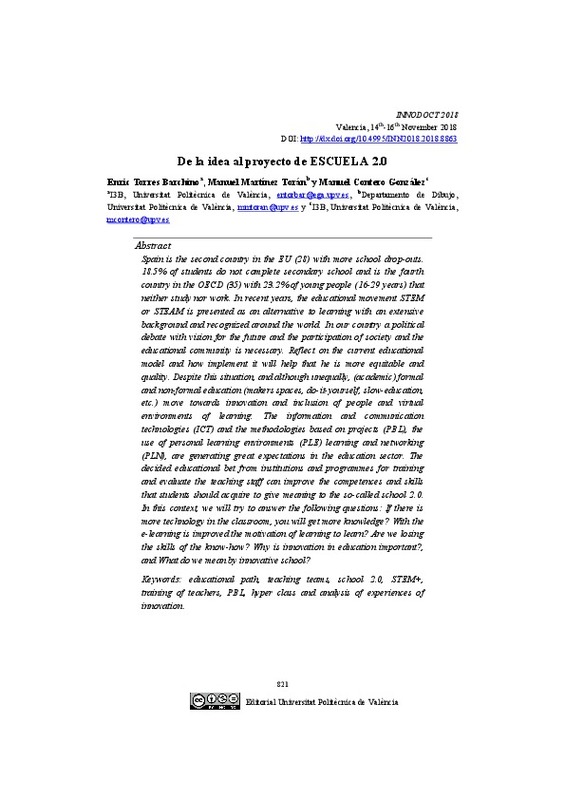|
Resumen:
|
[EN] Spain is the second country in the EU (28) with more school drop-outs. 18.5% of students do not complete secondary school and is the fourth country in the OECD (35) with 23.2% of young people (16-29 years) that neither ...[+]
[EN] Spain is the second country in the EU (28) with more school drop-outs. 18.5% of students do not complete secondary school and is the fourth country in the OECD (35) with 23.2% of young people (16-29 years) that neither study nor work. In recent years, the educational movement STEM or STEAM is presented as an alternative to learning with an extensive
background and recognized around the world. In our country a political debate with vision for the future and the participation of society and the educational community is necessary. Reflect on the current educational model and how implement it will help that he is more equitable and quality. Despite this situation, and although unequally, (academic) formal and non-formal education (makers spaces, do-it-yourself, slow-education, etc.) move towards innovation and inclusion of people and virtual
environments of learning. The information and communication technologies (ICT) and the methodologies based on projects (PBL), the use of personal learning environments (PLE) learning and networking (PLN), are generating great expectations in the education sector. The decided educational bet from institutions and programmes for training and evaluate the teaching staff can improve the competences and skills that students should acquire to give meaning to the so-called school 2.0. In this context, we will try to answer the following questions: If there is more technology in the classroom, you will get more knowledge? With the e-learning is improved the motivation of learning to learn? Are we losing the skills of the know-how? Why is innovation in education important?, and What do we mean by innovative school?
[-]
[ES] España es el segundo país de la UE(28) con más abandono escolar, el 18,5% de alumnos no terminan la ESO y es el cuarto de la OCDE(35) con el 23,2% de jóvenes (16-29 años) que ni estudian ni trabajan. En los últimos ...[+]
[ES] España es el segundo país de la UE(28) con más abandono escolar, el 18,5% de alumnos no terminan la ESO y es el cuarto de la OCDE(35) con el 23,2% de jóvenes (16-29 años) que ni estudian ni trabajan. En los últimos años, el movimiento educativo STEM o STEAM se presenta como una alternativa de integración de aprendizajes, además, cuenta con una amplia experiencia y de reconocimiento en todo el mundo. En nuestro país hace falta un debate político con visión de futuro, con la participación de la sociedad y de la comunidad educativa. Reflexionar sobre el actual modelo educativo y de cómo implementarlo ayudará a que sea más equitativo y de calidad. Pese a esta situación, y aunque de manera desigual, tanto la educación formal (académica), como la no formal (makers spaces, do-it-yourself, slow-education, etc.) se mueven hacia la innovación e inclusión de las personas y hacia entornos virtuales de aprendizaje. Las tecnologías de la información y de la comunicación (TIC), junto con las metodologías basadas en proyectos (PBL), el uso de entornos personales de aprendizaje (PLE) y de trabajo en red (PLN), están generando grandes expectativas en el sector educativo. La apuesta decidida de las instituciones educativas y de programas para la formación y evaluación del profesorado, pueden mejorar las competencias y habilidades que deben adquirir los alumnos para dar sentido a la denominada Escuela 2.0. En este contexto, trataremos de dar respuesta a las siguientes preguntas: ¿a más tecnología en el aula, se adquiere mayor conocimiento?, con el aprendizaje virtual (e-Learning) ¿se mejora la motivación por el aprender a aprender?, ¿se están perdiendo las habilidades del saber hacer?, ¿por qué es importante la innovación en educación?, y ¿dónde se están realizando experiencias educativas consideradas como innovadoras?
[-]
|









